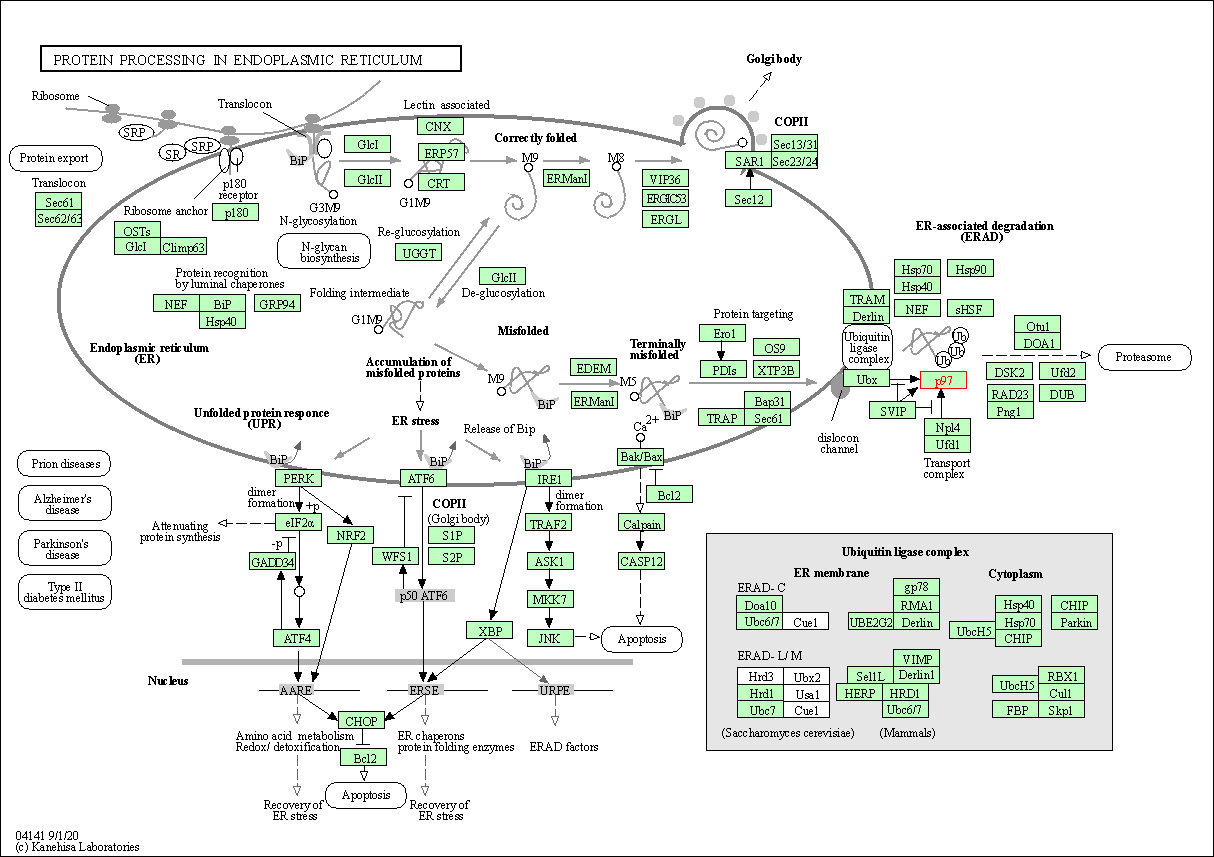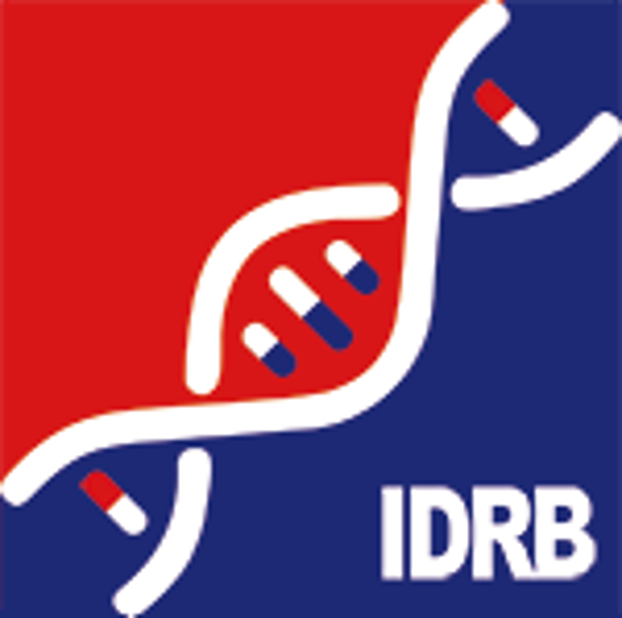Target Information
| Target General Information | Top | |||||
|---|---|---|---|---|---|---|
| Target ID |
T12646
(Former ID: TTDI02187)
|
|||||
| Target Name |
Valosin-containing protein p97 (VCP)
|
|||||
| Synonyms |
Valosin-containing protein; Transitional endoplasmic reticulum ATPase; TER ATPase; 15S Mg(2+)-ATPase p97 subunit
Click to Show/Hide
|
|||||
| Gene Name |
VCP
|
|||||
| Target Type |
Clinical trial target
|
[1] | ||||
| Disease | [+] 4 Target-related Diseases | + | ||||
| 1 | Acute myeloid leukaemia [ICD-11: 2A60] | |||||
| 2 | Multiple myeloma [ICD-11: 2A83] | |||||
| 3 | Myelodysplastic syndrome [ICD-11: 2A37] | |||||
| 4 | Solid tumour/cancer [ICD-11: 2A00-2F9Z] | |||||
| Function |
Involved in the formation of the transitional endoplasmic reticulum (tER). The transfer of membranes from the endoplasmic reticulum to the Golgi apparatus occurs via 50-70 nm transition vesicles which derive from part-rough, part-smooth transitional elements of the endoplasmic reticulum (tER). Vesicle budding from the tER is an ATP-dependent process. The ternary complex containing UFD1, VCP and NPLOC4 binds ubiquitinated proteins and is necessary for the export of misfolded proteins from the ER to the cytoplasm, where they are degraded by the proteasome. The NPLOC4-UFD1-VCP complex regulates spindle disassembly at the end of mitosis and is necessary for the formation of a closed nuclear envelope. Regulates E3 ubiquitin-protein ligase activity of RNF19A. Component of the VCP/p97-AMFR/gp78 complex that participates in the final step of the sterol-mediated ubiquitination and endoplasmic reticulum-associated degradation (ERAD) of HMGCR. Involved in endoplasmic reticulum stress-induced pre-emptive quality control, a mechanism that selectively attenuates the translocation of newly synthesized proteins into the endoplasmic reticulum and reroutes them to the cytosol for proteasomal degradation. Plays a role in the regulation of stress granules (SGs) clearance process upon arsenite-induced response. Also involved in DNA damage response: recruited to double-strand breaks (DSBs) sites in a RNF8- and RNF168-dependent manner and promotes the recruitment of TP53BP1 at DNA damage sites. Recruited to stalled replication forks by SPRTN: may act by mediating extraction of DNA polymerase eta (POLH) to prevent excessive translesion DNA synthesis and limit the incidence of mutations induced by DNA damage. Required for cytoplasmic retrotranslocation of stressed/damaged mitochondrial outer-membrane proteins and their subsequent proteasomal degradation. Essential for the maturation of ubiquitin-containing autophagosomes and the clearance of ubiquitinated protein by autophagy. Acts as a negative regulator of type I interferon production by interacting with DDX58/RIG-I: interaction takes place when DDX58/RIG-I is ubiquitinated via 'Lys-63'-linked ubiquitin on its CARD domains, leading to recruit RNF125 and promote ubiquitination and degradation of DDX58/RIG-I. May play a role in the ubiquitin-dependent sorting of membrane proteins to lysosomes where they undergo degradation. May more particularly play a role in caveolins sorting in cells. By controlling the steady-state expression of the IGF1R receptor, indirectly regulates the insulin-like growth factor receptor signaling pathway. Necessary for the fragmentation of Golgi stacks during mitosis and for their reassembly after mitosis.
Click to Show/Hide
|
|||||
| BioChemical Class |
Acid anhydride hydrolase
|
|||||
| UniProt ID | ||||||
| EC Number |
EC 3.6.4.6
|
|||||
| Sequence |
MASGADSKGDDLSTAILKQKNRPNRLIVDEAINEDNSVVSLSQPKMDELQLFRGDTVLLK
GKKRREAVCIVLSDDTCSDEKIRMNRVVRNNLRVRLGDVISIQPCPDVKYGKRIHVLPID DTVEGITGNLFEVYLKPYFLEAYRPIRKGDIFLVRGGMRAVEFKVVETDPSPYCIVAPDT VIHCEGEPIKREDEEESLNEVGYDDIGGCRKQLAQIKEMVELPLRHPALFKAIGVKPPRG ILLYGPPGTGKTLIARAVANETGAFFFLINGPEIMSKLAGESESNLRKAFEEAEKNAPAI IFIDELDAIAPKREKTHGEVERRIVSQLLTLMDGLKQRAHVIVMAATNRPNSIDPALRRF GRFDREVDIGIPDATGRLEILQIHTKNMKLADDVDLEQVANETHGHVGADLAALCSEAAL QAIRKKMDLIDLEDETIDAEVMNSLAVTMDDFRWALSQSNPSALRETVVEVPQVTWEDIG GLEDVKRELQELVQYPVEHPDKFLKFGMTPSKGVLFYGPPGCGKTLLAKAIANECQANFI SIKGPELLTMWFGESEANVREIFDKARQAAPCVLFFDELDSIAKARGGNIGDGGGAADRV INQILTEMDGMSTKKNVFIIGATNRPDIIDPAILRPGRLDQLIYIPLPDEKSRVAILKAN LRKSPVAKDVDLEFLAKMTNGFSGADLTEICQRACKLAIRESIESEIRRERERQTNPSAM EVEEDDPVPEIRRDHFEEAMRFARRSVSDNDIRKYEMFAQTLQQSRGFGSFRFPSGNQGG AGPSQGSGGGTGGSVYTEDNDDDLYG Click to Show/Hide
|
|||||
| 3D Structure | Click to Show 3D Structure of This Target | PDB | ||||
| HIT2.0 ID | T18SEF | |||||
| Drugs and Modes of Action | Top | |||||
|---|---|---|---|---|---|---|
| Clinical Trial Drug(s) | [+] 2 Clinical Trial Drugs | + | ||||
| 1 | CB-5083 | Drug Info | Phase 1 | Multiple myeloma | [2], [3], [4] | |
| 2 | CB-5339 | Drug Info | Phase 1 | Acute myeloid leukaemia | [5] | |
| Mode of Action | [+] 1 Modes of Action | + | ||||
| Inhibitor | [+] 2 Inhibitor drugs | + | ||||
| 1 | CB-5083 | Drug Info | [1] | |||
| 2 | CB-5339 | Drug Info | [6] | |||
| Cell-based Target Expression Variations | Top | |||||
|---|---|---|---|---|---|---|
| Cell-based Target Expression Variations | ||||||
| Drug Binding Sites of Target | Top | |||||
|---|---|---|---|---|---|---|
| Ligand Name: Adenosine triphosphate | Ligand Info | |||||
| Structure Description | Cryo-EM structure of human p97 in complex with NMS-873 in the presence of ATP, Npl4/Ufd1, and Ub6 | PDB:7LMY | ||||
| Method | Electron microscopy | Resolution | 2.40 Å | Mutation | Yes | [7] |
| PDB Sequence |
LSTAILKQKN
21 RPNRLIVDEA31 INEDNSVVSL41 SQPKMDELQL51 FRGDTVLLKG61 KKRREAVCIV 71 LSDDTCSDEK81 IRMNRVVRNN91 LRVRLGDVIS101 IQPCPDVKYG111 KRIHVLPIDD 121 TVEGITGNLF131 EVYLKPYFLE141 AYRPIRKGDI151 FLVRGGMRAV161 EFKVVETDPS 171 PYCIVAPDTV181 IHCEGEPIKR191 EDEEESLNEV201 GYDDIGGCRK211 QLAQIKEMVE 221 LPLRHPALFK231 EIGVKPPRGI241 LLYGPPGTGK251 TLIARAVANE261 TGAFFFLING 271 PEIMSKLAGE281 SESNLRKAFE291 EAEKNAPAII301 FIDELDAIAP311 KREKTHGEVE 321 RRIVSQLLTL331 MDGLKQRAHV341 IVMAATNRPN351 SIDPALRRFG361 RFDREVDIGI 371 PDATGRLEIL381 QIHTKNMKLA391 DDVDLEQVAN401 ETHGHVGADL411 AALCSEAALQ 421 AIRKKMDLID431 LEDETIDAEV441 MNSLAVTMDD451 FRWALSQSNP461 SALRETVVEV 471 PQVTWEDIGG481 LEDVKRELQE491 LVQYPVEHPD501 KFLKFGMTPS511 KGVLFYGPPG 521 CGKTLLAKAI531 ANECQANFIS541 IKGPELLTMW551 FGESEANVRE561 IFDKARQAAP 571 CVLFFDQLDS581 IAKARGGNIG591 DGGGAADRVI601 NQILTEMDGM611 STKKNVFIIG 621 ATNRPDIIDP631 AILRPGRLDQ641 LIYIPLPDEK651 SRVAILKANL661 RKSPVAKDVD 671 LEFLAKMTNG681 FSGADLTEIC691 QRACKLAIRE701 SIESEIRRER711 ERQPVPEIRR 733 DHFEEAMRFA743 RRSVSDNDIR753 KYEMFAQTLS770 FRFPS
|
|||||
|
|
ASP205
3.154
ILE206
3.624
GLY207
2.714
GLY208
4.960
CYS209
4.110
PRO246
4.076
PRO247
3.405
GLY248
3.025
THR249
2.969
GLY250
3.174
LYS251
2.836
THR252
2.657
LEU253
3.112
GLU305
4.661
ASN348
3.594
ILE380
3.587
ILE383
4.650
HIS384
4.731
GLY408
3.484
ALA409
3.304
ALA412
4.374
|
|||||
| Click to View More Binding Site Information of This Target and Ligand Pair | ||||||
| Ligand Name: CB-5083 | Ligand Info | |||||
| Structure Description | Cryo-EM structure of human p97 bound to CB-5083 and ADP. | PDB:7RLI | ||||
| Method | Electron microscopy | Resolution | 3.10 Å | Mutation | No | [8] |
| PDB Sequence |
NRPNRLIVDE
30 AINEDNSVVS40 LSQPKMDELQ50 LFRGDTVLLK60 GKKRREAVCI70 VLSDDTCSDE 80 KIRMNRVVRN90 NLRVRLGDVI100 SIQPCPDVKY110 GKRIHVLPID120 DTVEGITGNL 130 FEVYLKPYFL140 EAYRPIRKGD150 IFLVRGGMRA160 VEFKVVETDP170 SPYCIVAPDT 180 VIHCEGEPIK190 REDEEESLNE200 VGYDDIGGCR210 KQLAQIKEMV220 ELPLRHPALF 230 KAIGVKPPRG240 ILLYGPPGTG250 KTLIARAVAN260 ETGAFFFLIN270 GPEIMSKLAG 280 ESESNLRKAF290 EEAEKNAPAI300 IFIDELDAIA310 PKREKTHGEV320 ERRIVSQLLT 330 LMDGLKQRAH340 VIVMAATNRP350 NSIDPALRRF360 GRFDREVDIG370 IPDATGRLEI 380 LQIHTKNMKL390 ADDVDLEQVA400 NETHGHVGAD410 LAALCSEAAL420 QAIRKKMDLI 430 DLEDETIDAE440 VMNSLAVTMD450 DFRWALSQSN460 PSALRETVVE470 VPQVTWEDIG 480 GLEDVKRELQ490 ELVQYPVEHP500 DKFLKFGMTP510 SKGVLFYGPP520 GCGKTLLAKA 530 IANECQANFI540 SIKGPELLTM550 WFGESEANVR560 EIFDKARQAA570 PCVLFFDELD 580 SIAKARGGNI590 GDGGGAADRV600 INQILTEMDG610 MSTKKNVFII620 GATNRPDIID 630 PAILRPGRLD640 QLIYIPLPDE650 KSRVAILKAN660 LRKSPVAKDV670 DLEFLAKMTN 680 GFSGADLTEI690 CQRACKLAIR700 ESIESEIVPE730 IRRDHFEEAM740 RFARRSVSDN 750 DIRKYEMFAQ760 TLQQSRGFGS770 FRFPS
|
|||||
|
|
VAL474
3.438
ASP478
3.163
ILE479
3.526
GLY480
4.699
LEU482
4.513
GLY521
3.297
CYS522
3.480
GLY523
3.531
LEU526
3.021
LEU527
4.691
|
|||||
| Click to View More Binding Site Information of This Target and Ligand Pair | ||||||
| Click to View More Binding Site Information of This Target with Different Ligands | ||||||
| Different Human System Profiles of Target | Top |
|---|---|
|
Human Similarity Proteins
of target is determined by comparing the sequence similarity of all human proteins with the target based on BLAST. The similarity proteins for a target are defined as the proteins with E-value < 0.005 and outside the protein families of the target.
A target that has fewer human similarity proteins outside its family is commonly regarded to possess a greater capacity to avoid undesired interactions and thus increase the possibility of finding successful drugs
(Brief Bioinform, 21: 649-662, 2020).
Human Tissue Distribution
of target is determined from a proteomics study that quantified more than 12,000 genes across 32 normal human tissues. Tissue Specificity (TS) score was used to define the enrichment of target across tissues.
The distribution of targets among different tissues or organs need to be taken into consideration when assessing the target druggability, as it is generally accepted that the wider the target distribution, the greater the concern over potential adverse effects
(Nat Rev Drug Discov, 20: 64-81, 2021).
Human Pathway Affiliation
of target is determined by the life-essential pathways provided on KEGG database. The target-affiliated pathways were defined based on the following two criteria (a) the pathways of the studied target should be life-essential for both healthy individuals and patients, and (b) the studied target should occupy an upstream position in the pathways and therefore had the ability to regulate biological function.
Targets involved in a fewer pathways have greater likelihood to be successfully developed, while those associated with more human pathways increase the chance of undesirable interferences with other human processes
(Pharmacol Rev, 58: 259-279, 2006).
Biological Network Descriptors
of target is determined based on a human protein-protein interactions (PPI) network consisting of 9,309 proteins and 52,713 PPIs, which were with a high confidence score of ≥ 0.95 collected from STRING database.
The network properties of targets based on protein-protein interactions (PPIs) have been widely adopted for the assessment of target’s druggability. Proteins with high node degree tend to have a high impact on network function through multiple interactions, while proteins with high betweenness centrality are regarded to be central for communication in interaction networks and regulate the flow of signaling information
(Front Pharmacol, 9, 1245, 2018;
Curr Opin Struct Biol. 44:134-142, 2017).
Human Similarity Proteins
Human Tissue Distribution
Human Pathway Affiliation
Biological Network Descriptors
|
|
| Protein Name | Pfam ID | Percentage of Identity (%) | E value |
|---|---|---|---|
| RuvB-like 1 (RUVBL1) | 42.105 (24/57) | 4.00E-03 |
|
Note:
If a protein has TS (tissue specficity) scores at least in one tissue >= 2.5, this protein is called tissue-enriched (including tissue-enriched-but-not-specific and tissue-specific). In the plots, the vertical lines are at thresholds 2.5 and 4.
|
| KEGG Pathway | Pathway ID | Affiliated Target | Pathway Map |
|---|---|---|---|
| Protein processing in endoplasmic reticulum | hsa04141 | Affiliated Target |

|
| Class: Genetic Information Processing => Folding, sorting and degradation | Pathway Hierarchy | ||
| Degree | 57 | Degree centrality | 6.12E-03 | Betweenness centrality | 6.94E-03 |
|---|---|---|---|---|---|
| Closeness centrality | 2.47E-01 | Radiality | 1.43E+01 | Clustering coefficient | 7.83E-02 |
| Neighborhood connectivity | 2.19E+01 | Topological coefficient | 3.96E-02 | Eccentricity | 11 |
| Download | Click to Download the Full PPI Network of This Target | ||||
| Chemical Structure based Activity Landscape of Target | Top |
|---|---|
| Co-Targets | Top | |||||
|---|---|---|---|---|---|---|
| Co-Targets | ||||||
| Target Poor or Non Binders | Top | |||||
|---|---|---|---|---|---|---|
| Target Poor or Non Binders | ||||||
| Target Regulators | Top | |||||
|---|---|---|---|---|---|---|
| Target-interacting Proteins | ||||||
| Target Profiles in Patients | Top | |||||
|---|---|---|---|---|---|---|
| Target Expression Profile (TEP) | ||||||
| Target Affiliated Biological Pathways | Top | |||||
|---|---|---|---|---|---|---|
| KEGG Pathway | [+] 2 KEGG Pathways | + | ||||
| 1 | Protein processing in endoplasmic reticulum | |||||
| 2 | Legionellosis | |||||
| Reactome | [+] 2 Reactome Pathways | + | ||||
| 1 | Hedgehog ligand biogenesis | |||||
| 2 | Hh mutants that don't undergo autocatalytic processing are degraded by ERAD | |||||
| References | Top | |||||
|---|---|---|---|---|---|---|
| REF 1 | Pharmacological targeting of valosin containing protein (VCP) induces DNA damage and selectively kills canine lymphoma cells. BMC Cancer. 2015; 15: 479. | |||||
| REF 2 | ClinicalTrials.gov (NCT02243917) A Phase 1 Study Evaluating CB-5083 in Patients With Advanced Solid Tumors. U.S. National Institutes of Health. | |||||
| REF 3 | Clinical pipeline report, company report or official report of the Pharmaceutical Research and Manufacturers of America (PhRMA) | |||||
| REF 4 | Clinical pipeline report, company report or official report of the Pharmaceutical Research and Manufacturers of America (PhRMA) | |||||
| REF 5 | ClinicalTrials.gov (NCT04402541) Study of CB-5339 in Acute Myeloid Leukemia or Myelodysplastic Syndrome. U.S. National Institutes of Health. | |||||
| REF 6 | Clinical pipeline report, company report or official report of Cleave Therapeutics. | |||||
| REF 7 | Mechanistic insight into substrate processing and allosteric inhibition of human p97. Nat Struct Mol Biol. 2021 Jul;28(7):614-625. | |||||
| REF 8 | AAA+ ATPase p97/VCP mutants and inhibitor binding disrupt inter-domain coupling and subsequent allosteric activation. J Biol Chem. 2021 Oct;297(4):101187. | |||||
If You Find Any Error in Data or Bug in Web Service, Please Kindly Report It to Dr. Zhou and Dr. Zhang.

